Antarctica Fire History
Fire is one of the greatest threats in Antarctica, a very dry climate, frequent strong winds and a lack of liquid water with which to tackle any fires along with isolation and no possibility of rescue for weeks or months makes fire a potentially more disastrous event than anywhere else in the world.
Antarctic Fire Hazards
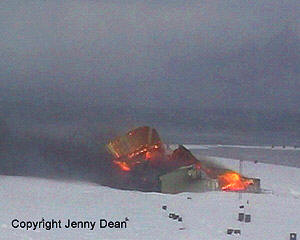 There
are no wild fires in Antarctica
There
are no wild fires in Antarctica
97% of the continent is permanently covered with snow and ice and the other 3% is largely bare exposed rock mostly seasonally covered in snow and ice. There is some vegetation, but nothing more than mosses, lichens and sparse growth of grass in limited areas, certainly nothing resembling a tree or a shrub of even the most stunted variety.
With the very unlikely exception of some exposed coal seams somehow catching fire or permanently damp banks of peat that have built up over thousands of years on sub-Antarctic islands igniting - of which there is no record or evidence - there is really nothing at all in Antarctica that is naturally there that burns.
Antarctica is a very dangerous place to have a fire, it is the single greatest danger to those living there
The fire hazards in Antarctica are faced by the human habitations of which there are about 65 in total with around 37 being manned year-round, the others are summer-only.
The cold temperatures make it very dry. As the windiest place on earth there is likely to be wind blowing at around gale force much of the time, more than strong enough to fan any flames. Finally, due to the temperature averaging below freezing across the whole continent, if there is a fire there is unlikely to be very much liquid water around to fight it with, if any at all.
The response to fire is therefore usually is to make sure everyone is out of danger and safe and then stand back and watch it burn itself out. Of course attempts are made to fight the fire, it's just that for the reasons stated above, they are rarely of any value. The safety of personnel and then the containment and prevention of the fire spreading are the most important issues.
As Antarctica is such an extreme environment and so remote from any chance of help or rescue, the prospect of a station being gutted means not only the loss of the building/s, but also possibly the loss of "life support".
Bases in Antarctica are often designed to survive fires by being made up of a number of separate buildings with a significant distance between them, if they are connected then it is by small insubstantial connections which themselves may be designed to be pulled down in case of fire. In this way if a building does catch fire, the chances are the fire won't spread to other nearby buildings.
The First Fire in Antarctica
The first recorded fire in Antarctica happened during the 1898-1900 British Antarctic Expedition led by Carsten E. Borchgrevink, aboard the Southern Cross. A member of the expedition accidentally set fire to his mattress with a candle during the winter nearly burning down the hut. If the hut had burnt down it could have led to the death of all members of the expedition following the loss of supplies and shelter.
As with most of the mistakes made by the early Antarctic explorers, it was a hard but well learned lesson. Many Antarctic stations have emergency supplies stored in a hut near to the station but well away so that if the unthinkable happens and the whole station burns down in the depths of winter when no-one can either get in or out, there will be enough supplies and shelter for the personnel to survive until help can arrive.
|
Significant Fires in Antarctica
- Summary more details below |
||||
| / - no data available | ||||
| Station | Date | Building/s | Casualties | Notes |
| Hope Bay, UK | 1948 | Whole base + store of materials for new base | 2 killed | Building and equipment destroyed, 1 survivor from 3 lived alone in a tent for 16 days until a field party returned after no radio contact. |
| Port Martin, France | 1952 | Main building | none | Building destroyed, no injuries, personnel moved 60km to newly built base at Petrel Island for the winter. |
| Mawson, Australia | 1958 | Main power house | / | Burnt down during construction |
| Mawson, Australia | 1959, April 3rd | Main power house | / | Burnt down |
| Mirny, USSR | 1960, August 3rd | 8 killed | ||
|
Almirante Brown Argentina |
1984, April 12th | Whole base | / | Burnt down by the station leader/physician so as not to stay another winter. The US ship Hero rescued the station personnel. |
| McMurdo, USA | 1991, May | Old Chapel - Quonset hut | none | Burnt down |
| Rothera, UK | 2001, Sept | Bonner marine laboratory | none | Building destroyed, caused by an electrical fault. Prevented 3 of 5 research projects in process at the time from continuing. |
| Progress - Russia | 2008, Oct 5th | 2 story building | 1 killed, 2 seriously injured | Building destroyed, radio equipment destroyed so unable to contact outside world for 4 days |
| Scott - New Zealand | 2009, May | A-frame hut | none | Building destroyed, caught fire during re-ignition of heater after re-fuelling. |
| Comandante Ferraz Base - Brazil | 2012, Feb 25th | Generator hut | 2 killed, 1 injured | Building and generators destroyed, over 40 evacuated to Punta Arenas, Argentina. |
The heavy equipment maintenance building burnt down at McMurdo station some years back. I saw pics of it when I was there but don't know anything about it. Jacob - Mcmurdo - USA
Hope Bay November 1948
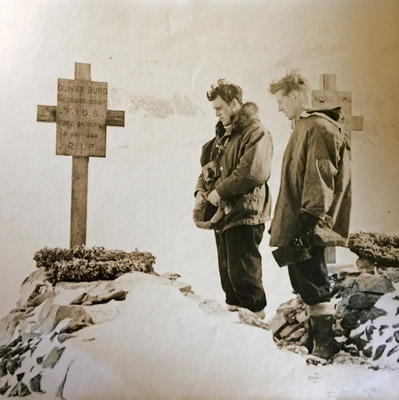
From "Of Ice and Men" by Sir Vivien Fuchs
"Elliott's party made all speed back to Hope Bay, covering eighty-five miles, in five days - thirty-nine on the last day. As the base gradually came into view they were surprised to see a tent, instead of a mound of snow with; chimneys standing through it, a large, gaping, black hole. This was a bad shock. The whole place seemed strangely silent, despite the noise now being, made by the few dogs that had been left behind. No one came out to met them, no puppies were bounding around, and even their own teams were quiet and subdued. On arrival it was clear that the tent had not been used for some time.
Elliott walked straight over to the rookery camp which the doctor, Bill Sladen, always used for observing penguins, confidently expecting to find three men. But only a very strained Sladen came out, and with difficulty told him that the base had been burned to the ground. Both Dick Burd* and Mike Green had died in the flames. He had kept his solitary vigil for sixteen days, unable to make any radio contact. He was in a state of deep shock, and that night it was mutually agreed that no one would talk about the fire.
In the morning details of this terrible tragedy were gradually unfolded. The fire had occurred while Sladen had been working over at the rookery. It is best described in his own words:
"The first thing I saw was a dense cloud of smoke, most of which was coming from the north end of the hut. The snow was dark with soot on the leeward side . . . . I found the door with difficulty and tried to push my way in ... billows of smoke rushed out ... the door was half drifted up . . . . I just managed to scramble out again . . . . I tried to force my way through the W/T window but was compelled to come out as the fumes were so hot and suffocating. There was no answer to frantic shouts made between breaths inside the window. As I ran round the south end of the hut I noticed a glow at the junction of the engine shed, back porch and main building. Snow was falling away around it and flames were being fanned by the gale. I tried pushing snow down into it but to no avail. . . . Smoke was coming out of every chimney . . . . . the roof at the south end was ablaze and . . . . I had to give up all hope of rescue. . . . The sinister silence; the dark smoke torrenting down to the sea, pressed low by the gale and drift; the feeling of complete and utter helplessness; worse still, the thought of Dick and Mike with no one to save them was the most terrifying thing I have ever experienced.
The main roof collapsed at approximately 0300. . . .
Between 0230 and 0300 I was moving all dogs at the east end of the spans to the west end. They were already blackened by the smoke.
At 0300 a piece of burning wood set light to the store dump for the new base on Hut Point nearly two hundred yards away . . . . I could do nothing as the sparks were rushing down in that direction. At 0345 the north extension of the hut was aglow and this roof fell in at 0400. At 0500 the hut was still burning and the store pile [fire] spreading rapidly. I went to investigate, but some ammunition exploded. I also remembered that there was a store of explosives on the Point.
At 0600 the smoke was less and it was possible to go into the Tin Galley [`The Cabin', saved from the fire because it was buried under snow] for a short rest out of the wind. I did not stay long for fear of fumes. The floor beams [of the hut] were still burning . . . . tins of condensed milk . . . . were bursting continuously. The stores on Hut Point were now burning with less vigour, but small ammunition was still exploding.
At 0700 the temperature was 13F . . . . the wind . . . . was mostly gusting to 40-50mph with some drift. I walked around trying to keep warm until 0800 by which time I was satisfied that there was no danger of anything else catching fire. I rested for three-and-a-half hours in my observation tent at the [penguin] rookery."
He pitched a tent near Andersson's hut at Seal Point and daily made unsuccessful attempts to contact Elliott on his field radio set. In an effort to divert his mind from the tragedy he continued his penguin studies.
. . . the heavy depression that seemed to well all around me; a feeling of great loneliness and deepest sorrow; the grim sight of utter desolation that greeted me every time I passed the still smouldering hut; the work we had struggled to do to the best of our ability under very trying conditions. Seven of us instead of nine (in 1947) . . . . the reports so carefully prepared and containing so much of interest and experience. All this seemed as nothing when my mind turned back to the two companions we would never see again. Their quiet and unruffled outlook on life had never ceased to impress me. I felt much in need of those qualities now.
*
Just thought you should know that the man identified as
Dick Burd is actually Oliver Burd, my uncle. "Dicky'
was a traditional nickname attached to the surname Burd,
much like "Dusty" Rhodes. My uncle was a Canadian
who attended a naval academy in the UK and subsequently
joined the British Navy. Rosemary Burd by email.
McMurdo Research Station - USA - McMurdo Sound, Antarctica - May 1991 - Old Chapel Fire
We experienced a fire in Antarctica in May of 1991, at McMurdo Station. I was there - I was the Navy's Officer in Charge of the Winter-Over Detachment. I think it was May 18th. I know for sure it was a Saturday night. The building was referred to as the Old Chapel. It was a typical Quonset hut, but was currently being used to store musical instruments and as a band practice area. The band was playing in the Club across the street that night, so there was little loss of contents. The Quonset hut, on the other hand, was destroyed. It was also located immediately adjacent to Building 155 (the main dormitory, galley, ship's store, laundry, etc.)Because of extremely cold temperatures and high winds (windchill was approximately -85F), the fire was difficult to fight - sparks were flying. Our fire fighters sprayed the side of Bldg 155 to create an ice barrier to prevent any sparks from catching that building on fire. The fire fighters spent about five hours fighting it and finally extinguished the fire by dumping loads of snow on what was left of the building around 4 am. No injuries or deaths. No determination of cause.
Mike Baldwin - by email
Rothera Research Station
- UK - Adelaide Island, Antarctic Peninsula - September 2001
- Bonner Marine Laboratory Fire
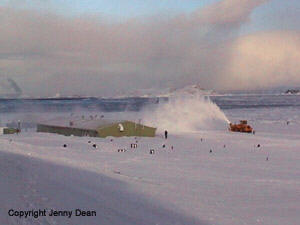 In
preparation for the arrival of the aeroplanes arriving
at the start of the summer, the runway is cleared of
snow by the snow blowers. This photo was taken 18 days
before the Bonner Laboratory was reduced to rubble by
a major fire. Attempts were made to try to put the fire
out, which included snowblowing as in this picture;
but to no avail.
In
preparation for the arrival of the aeroplanes arriving
at the start of the summer, the runway is cleared of
snow by the snow blowers. This photo was taken 18 days
before the Bonner Laboratory was reduced to rubble by
a major fire. Attempts were made to try to put the fire
out, which included snowblowing as in this picture;
but to no avail. The laboratory building already consumed by fire, this
is the moment that the roof was blown off. The miserable
day happened to also be the windiest of the winter with
winds gusting up to 80+ knots. Fire is a major threat
on base, this one caused by an electrical fault, and
is very difficult to tackle once it takes hold. Prevention
of injury to personnel is paramount, and luckily here
no one was hurt. However, the scientific work was severely
affected.
The laboratory building already consumed by fire, this
is the moment that the roof was blown off. The miserable
day happened to also be the windiest of the winter with
winds gusting up to 80+ knots. Fire is a major threat
on base, this one caused by an electrical fault, and
is very difficult to tackle once it takes hold. Prevention
of injury to personnel is paramount, and luckily here
no one was hurt. However, the scientific work was severely
affected.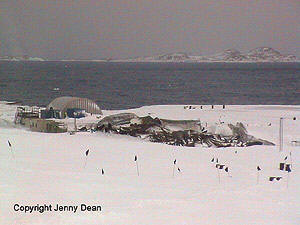 This
is what was left of the laboratory building at Rothera,
on the peninsula, that had been consumed by fire the
day before.
This
is what was left of the laboratory building at Rothera,
on the peninsula, that had been consumed by fire the
day before.Words and pictures by Jenny Dean
Scott Research Station - New Zealand - McMurdo Bay - May 2009 - A-Frame
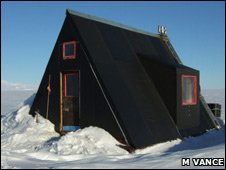 24
May 2009
24
May 2009MEDIA STATEMENT
A FRAME HUT FIRE IN ANTARCTICA
The iconic A Frame Hut near Scott Base, Antarctica burnt down on Saturday evening. A routine inspection and change over of diesel fuel tanks, which supplied the heating to the hut, was being completed by Scott Base Staff. Upon re-ignition of the heater the priming fuel flashed over and set fire to the hut. Attempts to fight the fire proved futile as the timber and bitumen hut burnt quickly.
Chief Executive of Antarctica New Zealand, Lou Sanson said, "We are extremely thankful that no one was seriously injured in the fire. It is a testimony to the skill of our staff that they were able to think quickly and remove themselves from harm."
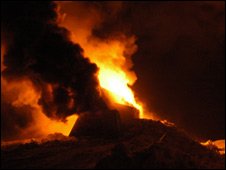 The
A Frame Hut had become an icon of the modern Antarctic era.
It was moved out onto the Ross Ice Shelf in 1971 from the McMurdo
Station ice wharf. Discarded by the United States Antarctic
Programme, the Kiwis of Scott Base quickly made it their own.
It was primarily used as a base for field training and as a
retreat for the staff of Scott Base. The A Frame Hut has housed
many notable New Zealand scientists, artists and politicians,
and was the favourite haunt of Sir Edmund Hillary.
The
A Frame Hut had become an icon of the modern Antarctic era.
It was moved out onto the Ross Ice Shelf in 1971 from the McMurdo
Station ice wharf. Discarded by the United States Antarctic
Programme, the Kiwis of Scott Base quickly made it their own.
It was primarily used as a base for field training and as a
retreat for the staff of Scott Base. The A Frame Hut has housed
many notable New Zealand scientists, artists and politicians,
and was the favourite haunt of Sir Edmund Hillary.Lou Sanson said, "The A Frame represented something uniquely Kiwi in Antarctica. It was the concept of a mountain hut mixed with a bach and it said something about who we are. The A Frame Hut will be sadly missed by all those who have been part of the New Zealand Programme in Antarctica over the last 38 Years".
Ends
BBC article
Progress Research Station - Russia - Larsemann Hills/Prydz Bay, East Antarctica - October 5th 2008 - Two Story Building
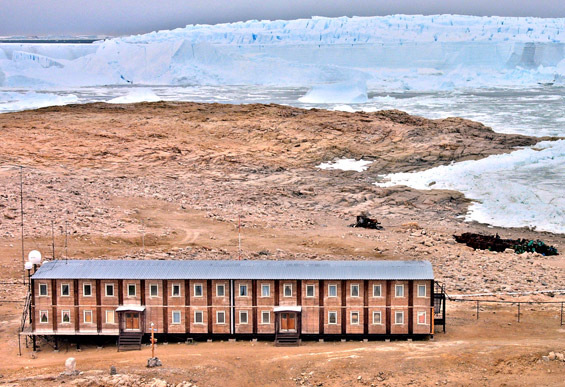 A
two-story building, part of Russia's Progress station in
Antarctica, caught fire killing one construction worker and
seriously injuring two others, the expedition's head said
on Thursday.
A
two-story building, part of Russia's Progress station in
Antarctica, caught fire killing one construction worker and
seriously injuring two others, the expedition's head said
on Thursday.
Valery Lukin said the fire broke out on Sunday on the station, where 29 people are based, completely destroying the radio equipment, which made it impossible to contact Russian officials about the incident until Thursday.
"All the radio equipment was destroyed. One of the station's construction workers... died, and two others received serious fractures and injuries," Lukin said.
The injured have been taken to a nearby clinic and are receiving the necessary medical treatment. "There is no need for an evacuation due to medical concerns," Russia's Arctic and Antarctic Research Institute said in a statement.
The earliest date that an evacuation could be carried out is early November.
An investigation into the fire is being carried out.
The Progress research station was opened in 1989 and is located
in the Larsemann Hills in East Antarctica. The station is around
1.5 kilometers from China's Zhong Shan research station,
where the injured Russians are receiving medical treatment.
ENDS
The personnel on the base at the time were unable to cope with the fire and the building was completely destroyed by the fire.
"At present, the station team lives in the old, small houses left by previous builders. The fire did not spread to the other station facilities, so we have the mess hall and the galley, the medical unit, 'warm' and 'cold' warehouses, all transport vehicles and also the facilities of the new wintering station under construction," Valery Lukin, head of RAE said.
"All food, fuel and medical supplies were preserved," Lukin added. "The people are provided with normal meals, polar clothing and medical service."
Photo Credit: Hannes Grobe/Alfred Wegener Institute MOSCOW, October 9 (RIA Novosti)
Comandante Ferraz Base - Brazil - Feb 25th 2012 - Generator Hut Origin
A fire broke out in a machine room housing electrical generators at about 2 a.m., an investigation found that an unattended fuel tank overflowed during refueling, an explosion and the subsequent fire were probably triggered by a short circuit. Two naval officers died while trying to fight the flames and another suffered a non life threatening injury, the rest of the station personnel were unharmed as the buildings were quickly evacuated.
The base is on King George Island which is home to about a dozen research stations belonging to a range of countries and the fire was at a time of year when there was a lot of activity from supply ships. Within 2 hours Chilean Navy firefighters had arrived with pumps, hoses and extinguishers to be shortly joined by others from Argentinian and British naval ships and some crew including a doctor from the nearby Polish research station. 44 of 59 people on the station were evacuated by helicopters at daybreak to the nearby Chilean Eduardo Frei station, being later flown to Brazil. 12 Brazilian naval personnel remained to fight the fire, though eventually bad weather caused fire fighting efforts to be suspended.
About 70% of the station was destroyed, the unaffected areas were isolated from the main building, it was dismantled in August 2012 and around 800 tonnes of debris were shipped back to Brazil in line with the Antarctic Treaty Environmental Protocol. Emergency modules were installed in 2013 to house researchers temporarily until a new station was built. Construction on the new station began in 2016 and is due to be completed in 2018, it will accommodate up to 64 people and have 18 laboratories.
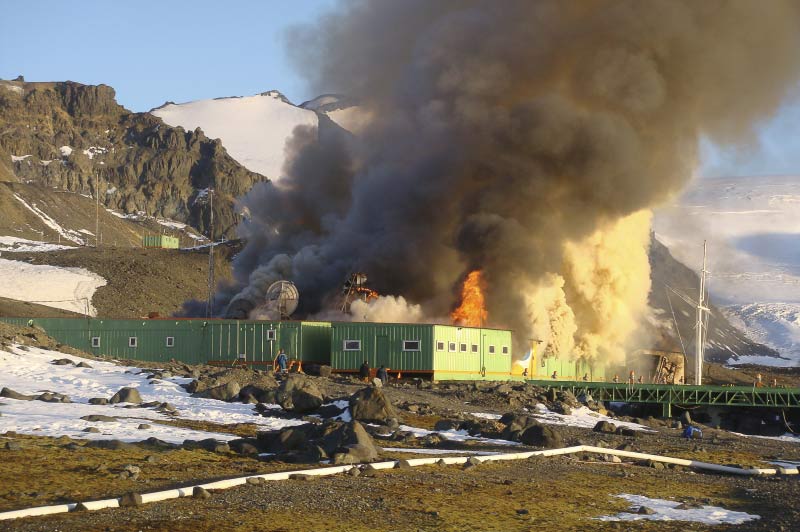
Arson
I wintered over at McMurdo in 1981 with the Naval Support Force. I was a Utilitiesman 2nd class assigned to the Maintenance Division.
Sometime in October, at a very late hour, one of my buddies and I were walking from the PO Club and noticed smoke coming from the Chapel. He ran back to the club and notified the Fire House who were on the scene within 3 minutes. While he was doing this, I was able to get inside and pull some of the pews away from the fire and when my buddy returned, we were able to pull a rug that was in flames out the back door before the Firemen arrived. Fortunately, only a small portion of the interior was damaged and was rebuilt the following summer. After the fire was put out, the Firemen could not find a cause and were baffled.
It was the next day that we found out that it was actually an attempted arson committed by one of our Winter Over friends who had become intoxicated and chose to commit this act in order to be flown out quicker than he had been originally scheduled. Another buddy of mine had seen him run out of the chapel but did not see any smoke or flame and thought nothing of it at the time so he went on to his quarters. He came forward the next morning after hearing what had happened and told of what he saw and thus the story goes.
I do not choose to reveal the arsonists' name seeing how this was an occurrence of 28 years ago (email received 2009). I can tell you that he was a Naval 1st Class Petty Officer who got his wish and was flown out at first flight, did not R&R in ChCh, and was flown directly back to the states where he was charged. I do not know the outcome of the charges.
By email
